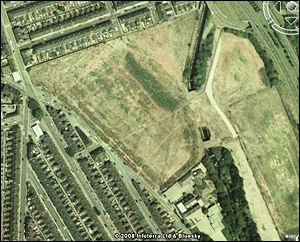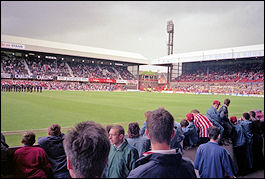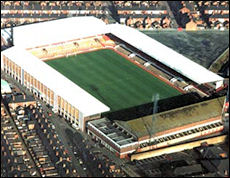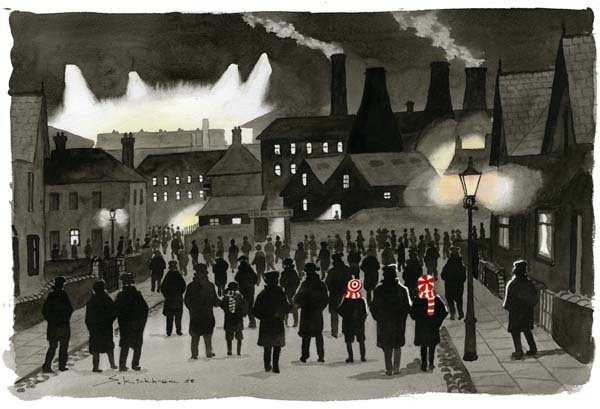|


The Britannia Stadium
The Britannia Stadium has of course been Stoke City’s home since 1997,
following the move from the club’s traditional home, the Victoria
Ground.
At the time it was considered to be a wise move for the club: the
Victoria Ground was old and dated; the club hadn’t invested seriously
in their home since the 1970s, and was under pressure to do something
in response to the Taylor Report which followed the Hillsborough
disaster in 1989. The majority of the Stoke support recognised the
club’s situation, and there was a positive response to the proposed
move, and it was also considered that the redevelopment of the club’s
former home would kick-start the regeneration of Stoke Town Centre.
|
The Britannia Stadium is of course now one of the city’s most
recognisable landmarks, sitting in a prominent hillside location
alongside the new A50, and next door to the municipal incinerator
(surely a metaphor for some of Stoke’s performances in their time at
the stadium?). There were ambitions for the stadium to be even more
prominent: there was an idea to site the stadium at the summit of a
large mound, and the City Council’s leader at the time, Ted Smith, was
a huge fan of the concept, stating “I want ‘em to see it from t’M6”.
Artist’s impressions of the new stadium were impressive, and whether
or not you are a fan of the architecture (it has been described as the
very best in East German design!), the stadium is a great local
landmark, and it is particularly impressive when lit up for evening
games, giving the impression of a huge cauldron of light, the venue of
some great human ritual, which I suppose it is. |
There has been criticism of the stadium from supporters though:
some have questioned the atmosphere when compared with the Victoria
Ground and suggested that this is due to having to sit as opposed to
stand (I have too, but I have a feeling that that has had more to do
with performances on the pitch more than anything else). The elements
have proved challenging at times (Stoke have had a game postponed here
due to strong winds).
The biggest criticism though has been the ability to access and leave
the stadium: this continues to be a big problem, and the fundamental
reason behind this is the stadium’s location on what is, in effect, a
giant out-of-town business park. It is designed for the car, and your
options to get there are very limited. Compare this to the old
Victoria Ground where you could get there on foot, by bus, or even by
train. However, there is no doubt that the facilities enjoyed are much
better. For example, the toilets at the back of the Boothen End at the
Victoria Ground were the only toilets that I know of that had a deep
end and a shallow end.

Aerial view of Stoke City’s former home
Stoke City’s move to the Britannia Stadium proved extremely
controversial, engineered by Stoke-on-Trent Regeneration Ltd – the
Joint Venture company between the City Council and St Modwen – who
were leading the reclamation and redevelopment of the former Hem Heath
Colliery.
The original concept was for the stadium to be a ‘community
stadium’, which as well as being the home of Stoke City, would also
be the venue for community events and rock concerts.
This led to accusations of the City Council favouring Stoke City
over the city’s other football club, Port Vale, and it is a row that
still rumbles on even now: one of Peter Coates’ first priorities on
his return to Stoke City was for him to ensure that Stoke City
gained full control of the stadium, and struck a deal to purchase
the City Council’s stake in the stadium for £4.5million.
This was considered to be less than the stake was worth, but given
that there was no one else likely to make such an offer, the City
Council accepted the club’s bid, and immediately promised to invest
the proceeds in the ‘regeneration of Stoke Town Centre’, something
that the club’s move to Trentham Lakes was intended to do ten years
earlier: indeed, the Victoria Ground continues to operate as a
vacant wasteland, and a monument to our city’s decline.
|
Both the Britannia Stadium and the Victoria Ground have a
very special place in my heart, but there is something missing
and that something is my dad. As with many boys, it was dad that
introduced me to my football, and Stoke City Football Club.
When I was young, I started to notice that dad would disappear
for a few hours on a Saturday afternoon, and when I asked mum
where he went, the reply that I got was simply “Stoke”. Dad
promised me that when I was big enough, he would take me along
too, and dad always kept his promises: on the evening of 28th
October 1981, I went to watch Stoke play Manchester City in the
second leg of the League Cup 2nd Round. I was
fascinated as Stoke played beneath the floodlights, and though I
don’t remember precise details, I know that Stoke won the game
2-0, but went out on penalties having lost the first leg 2-0.
After the game, dad made another promise: to take me to Wembley
one day to watch Stoke. It was another promise he kept; it was
just a pity it only arose following a relegation to the old
Third Division! And that was it, I was hooked and obediently
followed dad down to the Victoria Ground for much joy and equal
pain, and great memories.


The Victoria Ground
And what memories! The two of us being slung out of the
house by mum on Boxing Days to watch Stoke while she enjoyed the
telly. The fantastic 4-4 draw with Luton Town, and the cross
that got Mark Chamberlain in the England squad. Mad Mickey
Thomas and Sammy Mac running a midfield that helped Stoke play
their best football since the early 70s, including a 4-0
demolition of a great Watford team managed by future England
manager Graham Taylor, and including future England
internationals John Barnes and Luther Blissett.
The Great Escape of the 1983-84 season followed by the awful
1984-85 Holocaust. The 6-2 and 7-2 maulings of Leeds United in
successive seasons. The lows of the Alan Ball era, and the highs
of the Lou Macari era. The dreadful first season at the
Britannia Stadium, a season that started with such high hopes
(we should have known better: our ‘big’ summer signing was Paul
Stewart), but descended into farce following the 7-0 thrashing
by Birmingham City and the near-riot that followed. The
Icelandic takeover and eventual promotion under Gudjon
Thordarson. The return of Tony Pulis and Peter Coates, and the
return to the Big Time, and Rory’s Rockets. |

Calling all Potters - off to the match
Sid Kirkham
Football and Stoke City provided dad and me with a unique
father and son bond, a bond that will always be there even now dad has
gone. It is a bond that whilst is unique, is also common: a close
friend of mine has always had a strained relationship with his father,
but the one thing they do share is their love of Preston North End.
Stephen Foster’s excellent book ‘She Stood There Laughing’ is less
about Stoke City’s 2002-03 season than it is about his relationship
with his son.
The last Stoke game that dad went to with me was a home game against
Hull City towards the end of the season before last; the first game
that I shall be attending this season will be the home game against
Hull City. On 29th November, dad’s birthday. And while I
am looking forward to the game, and I know that I’ll enjoy it, it
just won’t be the same: my dad won’t be there with me.
My dad gave me a lot, and taught me a lot. He taught me the
difference between right and wrong. He taught me to live for today. He
gave me a sense of humour. And he gave me a love of football and Stoke
City, and whenever Stoke play, I think about him.
I’ve never warmed to the Britannia Stadium the way I did the Victoria
Ground, and dad no longer being around doesn’t help; maybe its because
the Victoria Ground is where the bond with dad is rooted, and would
explain the immense sadness I feel when I see the Victoria Ground now
in its current state: empty and abandoned alongside the D Road, still
and quiet, as if a circus has left town.
But the Britannia Stadium is home, and as long as Stoke City play
their football there, I will follow. And when I’m there, I’ll think
about my dad.
David Proudlove
29 November 2008 |
![]()
![]()
![]()